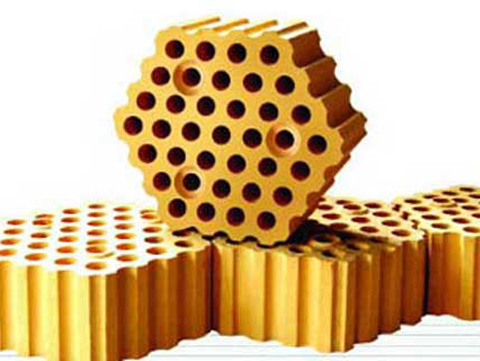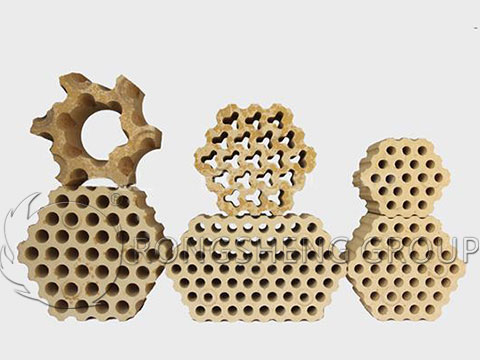Checkered bricks for heat storage of hot blast stoves. Clay checker bricks for hot blast stoves refer to the refractory materials for building the regenerators of hot blast stoves, which are mainly used for the lower part of the regenerators. Checker bricks for heat storage – checker bricks reheating furnace. According to different furnace types and different heat storage areas, it is usually divided into 7 holes, 19 holes, and 37 holes. Clay checker brick is a heat transfer medium used in the regenerator of blast furnace hot blast stove.

Comparison of the heat storage area of checkered bricks:
- (1) Traditional 7-hole lattice bricks: the diameter of the lattice holes is 43Mm, and the heat storage area is 38.1m2/m3;
- (2) High-efficiency 7-hole lattice brick: the diameter of the lattice hole is 30mm, and the heat storage area is 47.08m2/m3;
- (3) High-efficiency 19-hole lattice brick: the diameter of the lattice hole is 30mm, and the heat storage area is 48.6m2/m3;
- (4) High-efficiency 37-hole lattice bricks: the diameter of the lattice holes is 20mm, and the heat storage area is 68.7m2/m3.
Checker Bricks Product Category
Checker bricks for heat storage – checker bricks reheating furnace. Because clay bricks are widely used, in addition to conventional sizes, most of them are designed and customized according to furnace type requirements. The hole bricks have 7 holes, 19 holes, 37 holes, 65 holes, etc., and support customization.
Clay grate bricks for coke ovens use bauxite clinker, mullite, and coke gemstone as the main raw materials and soft bonded clay. Formed by high pressure and sintered at high temperature. Commonly used checker bricks have three rows of nine holes, three rows of fifteen holes, three rows of twelve holes, and two rows of fourteen holes (7.63 meters of coke oven).

Advantages and disadvantages of silica lattice bricks and high alumina lattice bricks
The checkered bricks in the middle and upper part of the regenerator are still in a higher temperature area, and at the same time, the checkered bricks in this area also bear the load of the upper checkered bricks, so the collapse of the checkered bricks occurs. That is to say, the damage to the checkered bricks in the quasi-high temperature zone is mainly caused by the uneven subsidence of the checkered bricks caused by creep. Especially when the high-temperature airflow on the cross-section of the checkered brick is unevenly distributed, the situation is particularly serious. For the checker bricks in the middle and lower parts of the regenerator, high alumina and clay refractory materials are usually used. With the increase in the height of the regenerator of the large-scale hot blast stove, the pressure of the upper lattice bricks on the lower refractory materials is also increasing. In addition, according to the damage investigation of large-scale high-temperature hot blast stove lattice bricks abroad, it was found that the cracking and breaking of lattice bricks caused by the influence of periodic temperature fluctuations on the lower lattice bricks is increasing. Therefore, in addition to continuing to control the creep characteristics of the lower clay bricks, higher requirements must be put forward for the normal temperature compressive strength and thermal shock stability of the products.
Silicon refractory is an acidic refractory material, which has good resistance to oxides such as CaO, FeO, and Fe2O3, and has the advantages of high softening temperature under load, stable volume at high temperature, and high thermal conductivity. However, the low temperature (below 800°C) has poor thermal stability. The specific realization is: that the softening temperature under load can be as high as (1640-1680°C), which is close to the melting point of tridymite (1670°C), and the thermal stability above 800°C is very good. Adapt to large changes in temperature. Silica bricks for hot blast stoves use tridymite as the main crystal phase, which has stable volume and low creep rate under high-temperature load, and its anti-adhesion performance is also better than other refractory materials. Proper use can make the structure of hot blast stoves more stable. However, at 200-300°C and 573°C, due to the crystal form transformation, the volume expands suddenly, which is easy to cause structural damage. Therefore, severe temperature changes should be avoided below 600°C.
Compared with silica bricks, high-alumina refractories have lower softening temperature under load and poor volume stability at high temperatures, but high-alumina refractories have the advantages of large capacity and good thermal shock stability.
Checker bricks for heat storage – checker bricks reheating furnace. Purchase high-quality regenerator checker bricks. Please contact Rongsheng Global refractory manufacturers.

